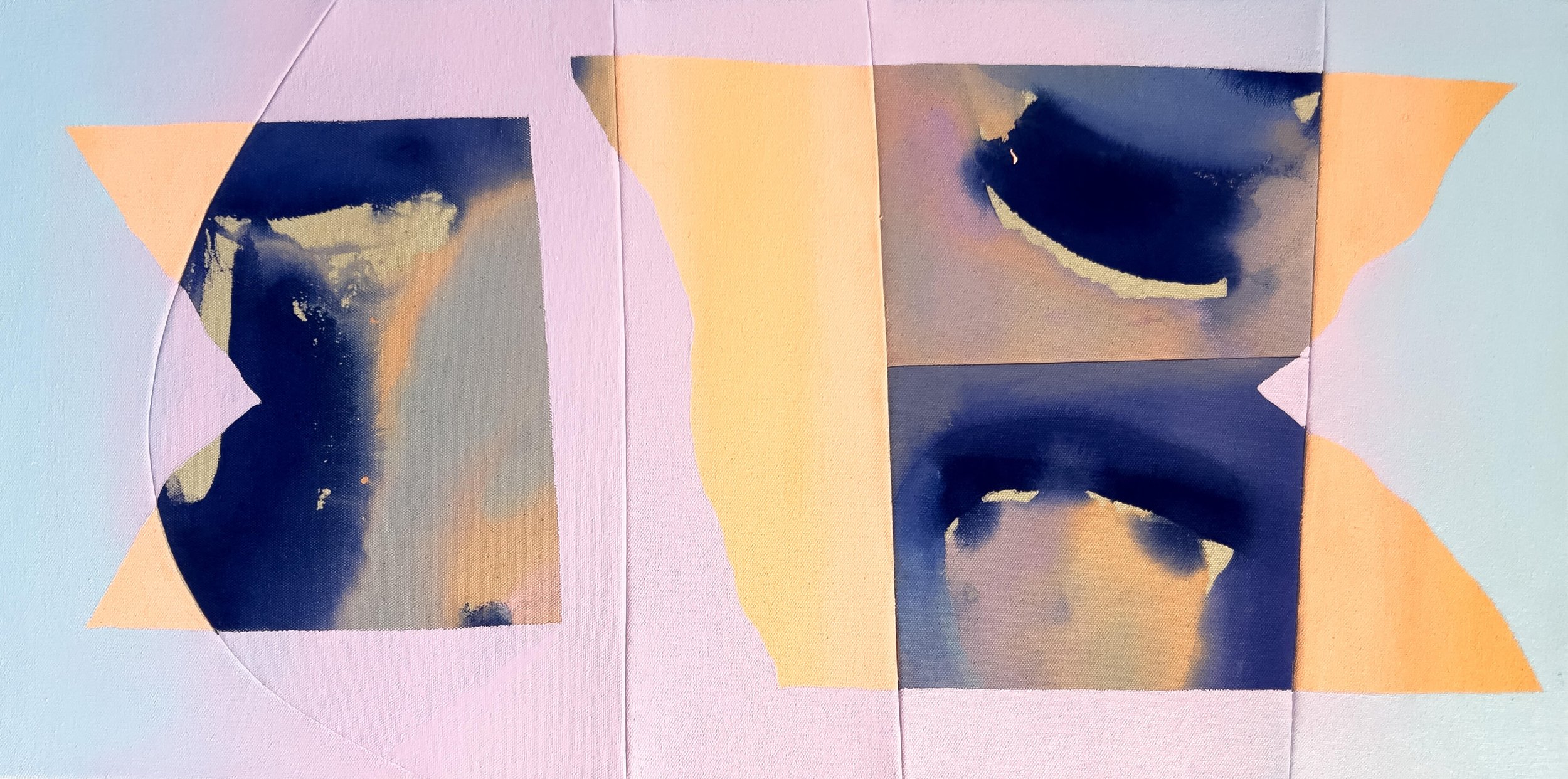Jes Moran
Jes Moran (b. 1983, Santa Clara, CA) is a Colorado abstract painter with an emphasis on acrylic stain painting on raw canvas. She creates saturated and vivid abstract artworks by pouring, staining, and brushing multiple layers of thinned acrylic pigments onto raw canvas. Afterward, she cuts and sews the canvas back together into new compositions. The final step in her process involves adding layers of gradient acrylic paint and window-like shapes, resulting in multidimensional and vibrant worlds. Moran is constantly engaged in the pursuit of capturing moments of presence and establishing a profound connection to her environment. From this, she immerses herself in the interplay of light, shadows, and color, translating these moments into her paintings.
Her techniques and aesthetics are influenced by her studies in painting, photography, apparel construction, and design. She attended Metropolitan State University of Denver for Fine Art and the Art Institute of Portland, Oregon, for Apparel Design. Select solo and group shows include The Space Gallery (2022), G44 (2022), The Lookup Gallery (2023), and Surface Gallery (2023). She has an upcoming solo exhibit at Kreuser Gallery in Colorado Springs in May 2024 and at G44 in April 2025.
www.jesmoran.com
How has the environment you grew up in affected your art practice?
Throughout my life, I've experienced a variety of different environments—from California and Wisconsin during my adolescence to Oregon in early adulthood, and finally settling in various cities along Colorado's Front Range for the past two decades. Embracing new places has exposed me to shifting landscapes, cities, homes, and even friendships. These changing environments have significantly influenced my art practice, as I've become accustomed to starting again in unfamiliar surroundings. My perception and observation of these new places, whether it's the play of light, reflection, forms, or colors, have become a crate full of memories. These translate into mysterious and multidimensional worlds within my work, evoking a sense of awe and wonder. The creation of imaginary landscapes satisfies the innate curiosity in me, much like an ant with antennas, seeking to unravel the unknown elements of our world.
If your artwork was a mirror, what would it reflect?
My paintings reflect the memories I've internalized from various places I've lived and experienced. Using chaotic soak stain painting, juxtaposed with sewn seams, gradient colors, and window-like shapes, I aim to depict dreamlike and atmospheric moments inspired by nature. These worlds represent the blending of my external and internal experiences, shaped by continuous observation and sensory input.
What is the most difficult part (or your least favorite part) of your process?
I create my paintings by pouring, staining, and brushing layers of thinned acrylic pigments onto raw canvas. Afterward, I cut the paintings into different parts and sew them back together to form new compositions. If I'm unsatisfied with the painting's direction, I must deconstruct it by removing the seams and sewing a blank canvas piece into that section. This process can be quite tedious, involving the careful removal of threads and addressing small holes left by the sewing needle. Additionally, I press the seams of the painting with an iron, although I despise ironing—the results are worth it. While the deconstruction and reconstruction of a piece can be tiresome, achieving the right sense of completion is incredibly rewarding.
Pursuing ‘artist’ as a career is not for the faint of heart. What is the most rewarding aspect of this pursuit?
I thrive on establishing a profound creative bond with my work. Witnessing the evolution of my art over time, alongside overcoming any fears associated with pursuing a career as an artist, is truly rewarding. To maintain my motivation, I prioritize finding fulfillment within myself. While the excitement of showing and selling my work is undeniable, these moments can be fleeting and unpredictable. Although anticipation for future opportunities is natural, they may not materialize as quickly as desired. Reflecting on my growth, celebrating small victories, and feeling proud of my achievements help me stay grounded. I achieve this by revisiting my past work and acknowledging the goals I've reached. By focusing on my personal growth, I remain driven, confident that consistent practice will lead to improvement and progress.
If your art is in a lineage of artists working within similar veins, who would be part of your lineage and why?
Helen Frankenthaler stands at the root of my artistic lineage, credited as the revolutionary behind soak stain painting. Following her pioneering work are Sam Gilliam's expansive canvas-soaked paintings. Moving forward, the minimalist light installations of James Turrell transport me to another dimension. Residing in Colorado Springs, I am fortunate to live just a short 15-minute drive from one of his Skyspace installations in Green Mountain Falls. The practice of cutting and sewing canvas feels like a familial inheritance, passed down from my paternal grandmother, who crafted clothes and quilts for her 11 children. I cherish the quilt she made that I inherited from my dad after she passed away.






